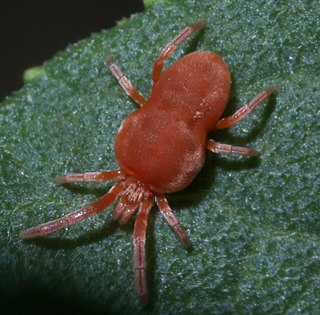Trombidium rowmundi is a species of mite in the genus Trombidium in the family Trombidiidae. It is found in Poland. The larvae of this species use spiders as a host.

Lorryia formosa, commonly known as the yellow mite or the citrus yellow mite, is a species of acariform mite. They are in the subfamily Tydeinae of the family Tydeidae. Commonly found on the foliage of citrus trees around the world, Lorryia formosa also associates with a variety of other plant types. The life cycle includes six discrete stages of development, and the lifespan averages about 37 days. The females of the species use an asexual form of reproduction where the growth and development of embryos occurs without fertilization by a male, a process called thelytoky.

Anystis is a genus of mites. They are predatory on other mites and small insects. Species in this genus are often red, long-legged, and range in size from 500μm – 1500μm. Both the genus and the family Anystidae are referred to as whirligig mites.

Calyptostoma is a genus of mites in the family Calyptostomatidae. There are about six described species in Calyptostoma.
Abrolophus marinensis is a species of mite belonging to the family Erythraeidae. It is named after the Marine de Farimore, Corsica, where the species was first collected. A. marinensis differs from its cogenerate species in its palptarsus having 2 setae with a tufty tip. It particularly differs from Abrolophus longicollis in its shorter length measurements.
Charletonia cuglierensis is a species of mite belonging to the family Erythraeidae, so named after its type locality. C. cuglierensis belongs to the group of species which possess two setae between coxae II and III. It differs from its cogenerate species by length measurements. It was first found in Sardinia, 6 kilometres (3.7 mi) south of Cuglieri.
Leptus pozzoicus is a species of mite. It is named after Porto Pozzo, near Santa Teresa Gallura, the place where the species was first collected. L. pozzoicus belongs to the group of species with two palpgenualae, and that have over four setae between coxalae II and III. It differs from its cogenerate species by various length measurements.
Abrolophus mirabelae is a species of mite belonging to the family Erythraeidae. It belongs to the group of species that have comb-like setae.
Erythraeus moeritzensis is a species of mite belonging to the family Erythraeidae. It belongs to the group of species that has a basifemoral, setal formula 3-3-3.
Erythraeus berninensis is a species of mite belonging to the family Erythraeidae. It belongs to the group of species that has a basifemoral, setal formula 3-3-3.
Allothrombium polikarpi is a species of mite belonging to the family Trombidiidae, first described from Greece.
Podothrombium manolatesicus is a species of mite belonging to the Trombidiidae family, first derived from Greece.
Erythraeus (Zaracarus) passidonicus is a species of mite belonging to the family Erythraeidae, first described from Greece.
Erythraeus kastaniensis is a species of mite belonging to the family Erythraeidae, first described from Greece.
Charletonia samosensis is a species of mite belonging to the family Erythraeidae, first described from Greece.
Charletonia kalithensis is a species of mites belonging to the family Erythraeidae, first described from Greece.
Pterodontia flavipes is a species of small-headed flies. Adult males are 5.5–10.5 mm in size, while adult females are 5–9 mm. The larvae are thought to enter their host spiders at the leg articulations. First instar larvae of the species have also been recorded attacking the mites Podothrombium and Abrolophus.

Abrolophus is a genus of mites in the family Erythraeidae, first described in 1891 by Antonio Berlese.

Allothrombium is a genus of mites belonging to the family Trombidiidae.
Charletonia is a genus of mites belonging to the family Erythraeidae.




